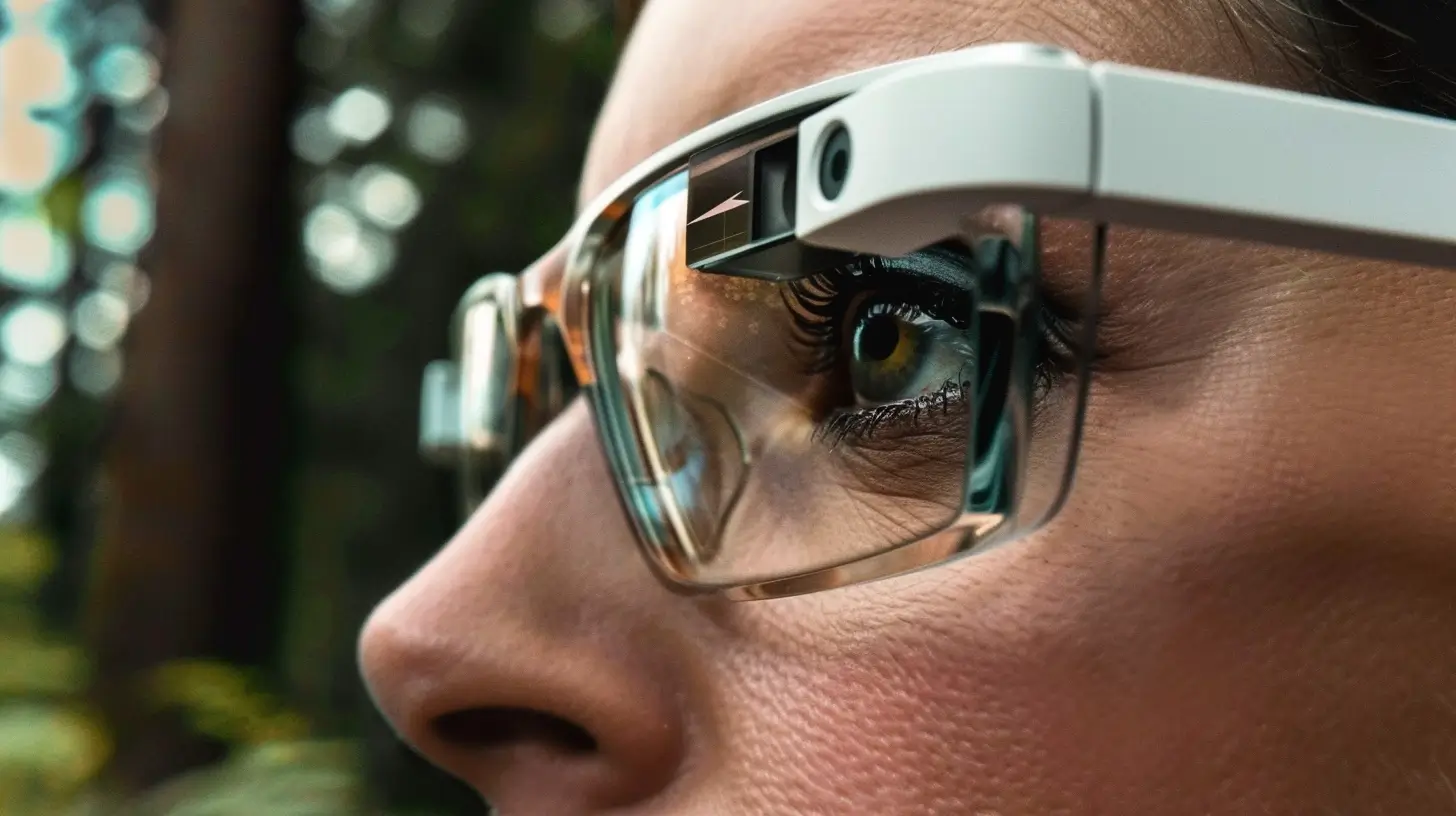The Future is Now: Unveiling the Next Gen of Smart Glasses
2024-03-07 | By Orcam Staff

In an age where technology seamlessly integrates into our daily lives, the future of smart glasses promises a revolution that will further blur the lines between the digital and the physical. As we stand on the cusp of this technological leap, smart glasses emerge as a beacon of innovation, combining the prowess of augmented reality (AR), artificial intelligence (AI), and wearable technology to redefine our interaction with the world around us. This article dives deep into the current state, emerging trends, and the boundless potential of smart glasses, guiding tech enthusiasts, potential buyers, and anyone curious about the future of wearable technology.
Introduction: A Glimpse into the Evolution of Smart Glasses
Smart glasses, once a figment of science fiction, have rapidly evolved into tangible tools enhancing everyday life. From their inception as bulky prototypes to their current sleek, fashion-forward designs, these devices have traversed a long path. Their impact stretches far beyond mere novelty, influencing various aspects of technology and daily living. By offering a hands-free digital experience, smart glasses have begun to transform how we navigate spaces, consume media, communicate, and monitor our health. This journey of evolution not only showcases the technological advancements but also hints at the potential for smart glasses to become as ubiquitous as smartphones.
The Current State of Smart Glasses
Features of Modern Smart Glasses
Today's smart glasses offer a myriad of functionalities designed to complement and enhance our digital lives. Navigation, communication, and entertainment are seamlessly integrated into our visual field, offering a new level of interaction with digital content. Health monitoring features are also increasingly common, providing real-time data on vital signs and fitness metrics. Some notable examples include:
North Focals: Focus on style and subtle notifications to keep you connected without pulling you out of the moment.
Snap’s Spectacles: Designed for capturing and sharing moments, these glasses feature built-in cameras and AR effects.
Bose Frames: Merge high-quality sound with ultramodern design, allowing users to listen to music or take calls without earphones.
Nreal Light: Offers a mixed reality experience, projecting high-quality virtual images over the real world.
Meta’s Rayban Smart Glasses: Combines classic Rayban style with the ability to capture photos, videos, and even play music.
These examples illustrate the diverse capabilities of current smart glasses, paving the way for more immersive and personalized digital experiences.
Integration with Other Devices
An essential aspect of modern smart glasses is their ability to integrate with other smart devices. Through Bluetooth connectivity, smart glasses can sync with smartphones, smartwatches, and even smart home devices. This interconnected ecosystem enhances the utility of smart glasses, enabling users to control various aspects of their digital life directly from their eyewear. Whether it’s skipping a track on a playlist, receiving turn-by-turn navigation, or controlling smart home appliances, the integration with other devices makes smart glasses an indispensable tool for the tech-savvy individual.
Key Innovations and Future Predictions
As we peer into the crystal ball of technology, several key innovations stand out, poised to propel smart glasses into a new era of ubiquity and utility. These advancements promise not only to enhance the functionality of smart glasses but also to address some of the current limitations, making them more integrated into our lives than ever before.
Integration of AR and AI: Enhanced Contextual Awareness, Real-Time Information Display
The fusion of augmented reality (AR) and artificial intelligence (AI) is set to redefine the smart glasses experience. AR brings digital elements to the real world, overlaying information onto our natural environment in a seamless and intuitive manner. AI enhances this by providing contextual awareness, allowing smart glasses to understand and predict the user's needs based on their environment, behavior, and even emotional state.
Imagine walking down the street, and your smart glasses instantly display the names, ratings, and wait times of nearby restaurants, tailored to your dietary preferences and past eating habits. Or, during a guided tour of a historical site, your glasses overlay real-time information about the architecture and history, personalized to your interests. This level of integration promises a future where digital information is not just accessible but anticipatory, enriching our interaction with the world in profound ways.
Advances in Battery Technology for Longer Life and Better Efficiency
One of the greatest challenges facing wearable technology is battery life. Future smart glasses will benefit from significant advances in battery technology, enabling longer use between charges and better overall efficiency. Innovations such as solid-state batteries or energy harvesting technologies, which convert body heat or solar power into electricity, could dramatically extend the operational time of smart glasses.
This leap forward in battery technology means users can enjoy immersive experiences without the constant concern for battery depletion, making smart glasses more practical for everyday use. Whether for professional applications or personal leisure, the ability to rely on smart glasses throughout a busy day marks a significant step towards their widespread adoption.
Improvements in Data Privacy and Security Measures
As smart glasses become more integrated into our lives, capturing and processing vast amounts of personal data, concerns around privacy and security become paramount. Future generations of smart glasses are expected to incorporate advanced data protection measures, utilizing encryption and secure data storage to safeguard user information.
Moreover, AI could play a crucial role in enhancing privacy, by learning to recognize sensitive information and automatically blurring out faces or license plates in real-time video feeds, for instance. These improvements will be crucial in building consumer trust and ensuring that the benefits of smart glasses do not come at the expense of personal privacy.
Increased Affordability and Accessibility in the Market
As with any emerging technology, the initial cost of smart glasses has been a barrier to widespread adoption. However, as the technology matures and production scales, prices are expected to drop, making smart glasses more accessible to a broader audience. This democratization of technology will not only open up new markets but also foster innovation as more developers and companies engage with the platform.
Increased affordability also means that the benefits of smart glasses, from educational enhancements to health monitoring, will be available to a more diverse group of users. This inclusivity is vital for realizing the full potential of smart glasses in transforming how we interact with information, each other, and the world around us.
As we look to the future, it's clear that smart glasses are on the brink of a transformative leap. With advancements in AR and AI, battery technology, privacy measures, and market accessibility, the next generation of smart glasses promises to enrich our lives in ways we're only beginning to imagine.
The Evolution of Wearable Technology in Daily Life

The intersection of augmented reality (AR) glasses, artificial intelligence (AI), and wearable technology has ushered in an era of wearable computing that seamlessly integrates with our daily lives. This convergence has made smart wearable devices not just a convenience but a transformative medium for experiencing, interacting with, and understanding the world around us.
Benefits of Smart Glasses in Education
Smart glasses are revolutionizing the educational sector by providing immersive learning experiences. Through augmented reality glasses, students can explore complex concepts in a visually engaging manner. Imagine history lessons where students can witness historical events unfold right before their eyes or science classes where complex biological processes are demonstrated in 3D, right on their desks. The integration of real-time data into these educational experiences enhances understanding and retention, making learning not just interactive but also incredibly effective.
Smart Glasses for Augmented Reality Gaming
In the realm of entertainment, smart glasses are taking augmented reality gaming to unprecedented levels. By blending the digital and physical worlds, these devices offer gamers experiences that are deeply immersive and interactive. Gamers can use voice commands to control gameplay or navigate through virtual worlds, all while receiving real-time data about their environment or game stats. This hands-free technology allows for a level of engagement and freedom that traditional gaming platforms cannot match.
How Smart Glasses Improve Health Monitoring
The impact of smart glasses extends into the health sector by improving health monitoring and patient care. Wearable computing technologies enable continuous monitoring of vital signs and fitness metrics, providing users with real-time data about their health. This can be a game-changer for patients with chronic conditions, allowing for early detection of potential issues and timely medical intervention. Additionally, the hands-free nature of smart glasses means that health data can be accessed easily by both the wearer and healthcare providers, improving the efficiency and effectiveness of patient care.
The Integration of Wearable Computing in Daily Life
As wearable computing continues to evolve, smart glasses are becoming an integral part of our digital lives. These devices are not just about accessing information or entertainment; they represent a shift towards a more interactive, connected, and data-driven world. Real-time data, provided by smart wearable devices, enhances our decision-making, improves our productivity, and enriches our personal and professional lives.
Looking Forward
As we move forward, the integration of AR, AI, and wearable computing promises to make smart glasses an indispensable part of our future. Whether it's enhancing learning, revolutionizing gaming, or transforming health monitoring, the potential of smart glasses is immense. As technology continues to advance, the best smart glasses will offer more than just a glimpse into the future; they will become a key component of our everyday lives, redefining what is possible with wearable tech trends and smart wearable devices.
Overcoming Challenges and Embracing Opportunities
As the landscape of smart glasses and wearable technology continues to evolve, it faces its share of challenges. However, each challenge also presents a unique opportunity for growth and innovation. Addressing these concerns is essential for the continued adoption and evolution of smart glasses.
Privacy and Data Security
One of the paramount concerns with the adoption of smart glasses is privacy and data security. As devices capable of capturing and disseminating real-time data, it's crucial that manufacturers implement stringent security measures to protect user data. The opportunity here lies in developing advanced encryption technologies and secure data handling practices that can set new standards for privacy in wearable technology. By ensuring that users' information is safe, manufacturers can increase trust and acceptance among potential users.
Wearable Computing and User Interface
Another challenge is creating user interfaces that are intuitive and user-friendly. The future of smart glasses depends on their ability to blend seamlessly into the user's life, which requires interfaces that respond to natural gestures, voice commands, and even eye movements. This challenge opens the door to innovative solutions in natural language processing and machine learning, making interactions with smart wearable devices as natural as conversing with a friend.
Battery Life and Device Efficiency
The practicality of wearable technology like smart glasses is often limited by battery life. To overcome this, ongoing research into more efficient power sources and energy-harvesting technologies presents a significant opportunity. Innovations such as solar-powered glasses or kinetic energy harvesting could redefine the autonomy of wearable devices, making them truly integrated into our daily lives without the constant need for recharging.
Adoption in Various Sectors
The versatility of smart glasses means they have potential applications across numerous sectors, from education and healthcare to construction and entertainment. However, widespread adoption requires not only technological advancements but also a shift in perception. Here, the opportunity lies in demonstrating the tangible benefits of smart glasses in these various fields, such as how they can enhance learning, improve patient outcomes, streamline operations, and enrich entertainment experiences. Pilot programs and partnerships with industry leaders can pave the way for broader acceptance and integration of smart glasses into professional and personal realms.
The Future Is Wearable

As we stand at the forefront of this technological revolution, it's clear that the future is wearable. Smart glasses represent just the beginning of what's possible with augmented reality, artificial intelligence, and wearable computing. The next generation of smart glasses will not only provide us with information and entertainment but will also enhance our ability to interact with the world around us in more meaningful and productive ways.
The future of smart glasses is bright, filled with potential to transform everyday life for people around the globe. As technology advances, we can expect to see smart glasses that are not only more powerful but also more accessible to a wider audience. The journey ahead for smart glasses and wearable technology is undoubtedly exciting, promising a world where digital information becomes a seamless, integral part of our physical reality.
Pushing the Boundaries: OrCam MyEye
Among the myriad of smart glasses revolutionizing our interaction with the digital world, OrCam MyEye stands out as a beacon of innovation, particularly for its profound impact on the visually impaired community. This device transcends the conventional boundaries of wearable technology by providing a lifeline to those who navigate the world in darkness or with limited vision.
OrCam MyEye is a compact, intelligent device that clips onto the wearer's glasses. It employs advanced computer vision algorithms to read text, recognize faces, and identify products in real time, converting visual information into spoken words. This enables users to read books, newspapers, and even digital screens without needing to see them physically. Moreover, by recognizing familiar faces and everyday products, OrCam MyEye offers a layer of social and practical convenience that was previously inaccessible to many.
The unique benefits of OrCam MyEye in the smart glasses landscape are its focus on accessibility and empowerment. While most smart glasses aim to enhance the digital experience for the average user, OrCam MyEye targets a specific, often overlooked community, offering them independence and a richer interaction with their surroundings. This focus on inclusivity and practical assistance is what sets OrCam MyEye apart, illustrating the potential of smart glasses to transform lives beyond entertainment and productivity.
Conclusion
The journey of smart glasses, from their conceptual beginnings to their current state as cutting-edge wearable technology, showcases the incredible potential of augmented reality (AR), artificial intelligence (AI), and wearable computing to redefine our daily lives. As we've explored, from enhancing educational experiences to revolutionizing healthcare and offering new realms of entertainment, smart glasses are at the forefront of the next technological revolution.
Looking ahead, the future of smart glasses is not just promising; it is already unfolding. With innovations like OrCam MyEye leading the charge, we're witnessing a shift towards more inclusive, empowering, and transformative uses of technology. As developers continue to push the boundaries of what's possible, addressing challenges such as privacy, user interface, and battery life, smart glasses will become more integrated into our lives, seamlessly blending the physical and digital worlds.
The role of smart glasses in shaping our technological future cannot be understated. They stand as a testament to human ingenuity, offering a glimpse into a future where our digital and physical realities merge in ways that enrich, enhance, and simplify our daily experiences. As we continue to explore and expand the capabilities of smart glasses, one thing is clear: the future is not just coming; in many ways, it's already here.



